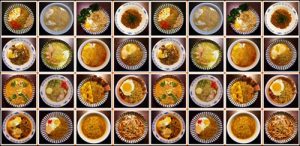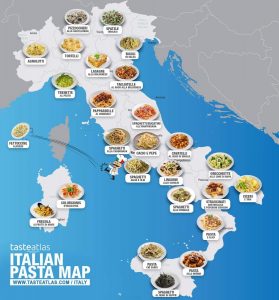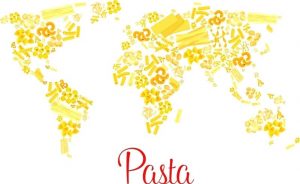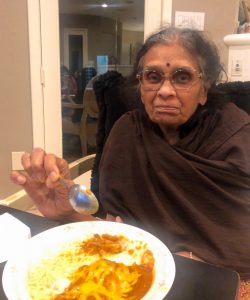On this holy day filled with gaiety and devotion,
We come to commemorate the enduring love saga of Ras Lila.
Malicious spirits are set to burn in a bonfire amidst merriment,
And riot of pastel colors paint the canvas of the sky.
With love and devotion overpowering evil,
We take up a mango blossoms and sandalwood paste as offerings from god,
And boil thin strands of vermicelli in fragrant sweet yellow milk,
With notes of cardamom and saffron,
Served in clay plots and decorated at the top with cashews and raisins.
As spring begins and the flowers bloom at the spirit of the nation,
The sound of the dholak with the crowds running lets no one rest.
Once trees are painted pink and the color runs out,
The traditional melodies wind down,
And homes are filled with an aroma of ecstasy.
Once the plates have been emptied,
Harmony is achieved in the nation,
As India and god witness the color of true peace.
-
What piece did you choose to imitate?
I chose a piece that I found very intriguing, which was “Dong Huang Taiyi (Grand Unity, Spirit of the Eastern Sky)” written by Chu Ci by Qu Yuan.
-
Why did you choose this piece?
Coming from a religious Hindu family, I felt rather sentimental while reading “Dong Huang Taiyi” as this poem primarily revolves around an auspicious day. He describes the event in spiritual terms by using the food and singing served on this day. The scene painted through the poet’s words reminded me of the value that many dishes from India hold, which is that of spirituality. In India, many of the foods served on holidays serve as a link between the people eating it and god. Singing in “Dong Huang Taiyi” is also used to illustrate spirituality, just as how many of the ballads we sing on religious holidays in India are odes to the gods and serve to link the community. The title of the poem “Grand Unity, Spirit of the Eastern Sky” inspired me to choose a popular ancient festival in India called ‘Holi’.
Holi is known as the festival of colors or love, and marks the beginning of spring. It is celebrated to commemorate the love saga of radha and krishna, which are two gods of hinduism. The night before Holi, people gather and perform religious ceremonies in front of a bonfire where they pray to destroy and burn their internal evil the same way that Holika, sister of the demon king Hiranyakashipu, was killed in the fire. The next morning is Holi, and people throw and drench each other in colorful powders. Everyone participates in this festival, and everyone, including the rich and poor, finally mix during this celebration of love. Many groups carry drums, known as dholaks, and other musical instruments as they go from place to place singing and dancing. The spiritual day is also filled with ‘seasonal delicacies’ like those we read about in Chinese culture in the reading “Food and Drink Traditions” in Chinese Food by Liu Junru. The dish mentioned in my poem is called Kheer (photo attached below), which is a particular ‘seasonal delicacy’ that is eaten on this auspicious day.

-
What did you learn about the culture of the original author through imitating his or her style?
Through “Dong Huang Taiyi”, it is evident that the Chinese link their food to the spiritual world, similar to practices in India. One line that really spoke to me was, “Take up the fragrant flower offerings, the meats cooked in melilotus, served on orchid mats, And libations of cinnamon wine and pepper sauces!” What I understand here is that food offerings and songs are used to please the holy spirits and deities, and are seen as ‘seasonal delicacies’. We studied this idea of ‘seasonal delicacy’ in class and particularly read about in “Food and Drink Traditions” in Chinese Food by Liu Junru, which demonstrated how by eating zongzi during the dragon festival you are in essence celebrating not only the life of Qi yuan but the loyalty and spirit that Chinese people take large pride in as a community. These actions and ‘seasonal delicacies’ really show how culture and traditions are deeply embedded into Chinese festivals, and that food surpasses its normal connotation of nutrition and extends to a symbolic spiritual meaning in China.
-
What did you learn about your own culture while writing?
When researching about my own culture while writing this Journal Entry, I found that there are several ways the noodle, namely the vermicelli noodle, plays a role in popular dishes that are synonymous with certain auspicious festivals. I chose Holi, as I knew Kheer was a popular noodle-based dessert that is served during the festival. However, upon further research I was very surprised to find all the other roles the noodle plays in our Indian dishes! I never even noticed that the vermicelli noodle had such a big presence in our Indian spiritual dishes, and always thought of it to be more of a Southeast Asian staple. This peaked my curiosity, and I was further curious to learn about other festivals in India that have similar noodle-based dishes accompanying them. I found out that at Diwali, which is known as the Festival of Light, kheer is a popular dish that is also served then, in addition to dish called falooda. Falooda (shown below) is a cold dessert made by mixing rose syrup, vermicelli noodles, and sabja seeds (aka basil seeds) in sweet milk, and is often served with ice cream. Not only did I learn how certain food items have become synonymous with certain festivals and auspicious occasions, but I also learned that many of these ‘seasonal delicacies’ incorporate the noodle!

-
Is there cultural DNA embedded in the piece you read and in your piece? How does this DNA manifest in the texts?
I have noticed a lot of similarities between auspicious festivals in China and India, primarily the methods of celebration. In India, festivals are loud, vibrant, and full of energy. This emotion and feeling is resonated in the poem as the author writes, “Flourish the drumsticks, beat the drum!…The singing begins softly to a slow solemn measure, malicious spirits are set ablaze in a bonfire”. This energy and singing inspired me to illustrate how music also plays a major role in Indian spirituality as depicted when I wrote “As spring begins and the flowers bloom at the spirit of the nation, The sound of the dholak with the crowds running lets no one rest.” Also, the concept of food and the preparation of food is very similar in both Indian and Chinese culture and society. Food is very important in many auspicious festivals, and the type of delicacy prepared is synonymous with the type of auspicious occasion. This can be seen when the poet writes, “Take up the fragrant flower offerings, The meats cooked in melilotus, served on orchid mats, And libations of cinnamon wine and pepper sauces”. I took this idea of offerings from god and ‘seasonal delicacies’ and translated it “With love and devotion overpowering evil, We take up a mango blossoms and sandalwood paste as offerings from god, And boil thin strands of vermicelli in fragrant sweet yellow milk, With notes of cardamom and saffron, Served in clay plots and decorated at the top with cashews and raisins.” Furthermore, the idea of pleasing the gods and harmony that is mentioned in the poem reminded me of the idea of harmonizing flavors from the “Food and Drink Traditions” in Chinese Food by Liu Junru. As mentioned in the reading, if food is harmonized, it is guaranteed that the bodies of the people will also be balanced and harmonized. The outcome of this is whole communities living in harmony as well, which is a very Daoist approach. I believe Indians also follow this approach in their foods and I translated this concept in my poem as “Once the plates have been emptied, Harmony is achieved in the nation, As India and god witness the color of true peace.”
Works Cited- Images:
https://mytastycurry.com/rose-falooda-recipe-how-to-make
http://www.ekunji.com/recipes/vermicelli-kheer-recipe-video/










